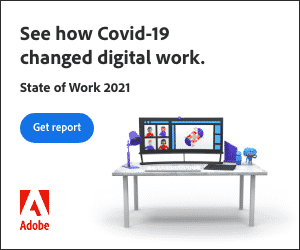 Aug 13, 2021 |
|
Good morning, Marketer, are your customers and prospects thinking about content? Certainly, they consume it. But are they thinking about content the way marketers do? Probably not. And yet, they demand content. So it’s a good idea to pay close attention to this demand wherever it is, and build out a content demand chain. The Real Story’s Tony Byrne has much more to share on this topic below. In many cases, your customer is consuming the content while doing something else. They’re solving a problem, at home or work, and they need content to help them. Or, they’re completing a mindless task, or working out, and need something to fill the silence. The content serves as a link to engage with this customer. If it’s content on an e-commerce ready publisher, or on a social media platform equipped with a buy button, then part of the engagement can be a sale. Our coverage, further down, of the HBO Max Orbit in-store experience shows how engagement with content can become a memorable, full-body experience. And part of an engaging on-site experience located in a physical retailer is being able to buy something to take with you on the way out. Content doesn’t have to be the main draw, but it’s a consistent part of the journey. Chris Wood,
Editor |
|
| | | Management | | | | | Consider supply and demand chains for your marketing content | | Businesses frequently think in terms of supply chains and demand chains: processes and networks that drive inputs for your products and services, and then structure their eventual consumption. Could the same concepts apply for inputs and outputs from your martech stack? “On the content side,” writes Tony Byrne of Real Story Group, “I think the answer is ‘yes.’” Demand for marketing and engagement content expanded during the pandemic, with content marketers somehow “muscling through,” using too many manual steps and poor coordination. This is unlikely to be a sustainable approach. Supply chain as a concept also helps in the understanding of content production and management as a process flow. When aligned with product supply chain and marketing campaign planning, it helps show why content production needs to be engaged at each step, rather than as an afterthought at the end. “More importantly,” Byrne writes, “as we transition from thinking about supply chains to demand chains, then opportunities arise to effectively manage omnichannel content components, featuring mixed text, media, and data that can be deployed to diverse contexts.” Read more here. |
|
| | | | 5 tactics to scale your agency | | Digital technology is a $220 billion market that is rapidly expanding and comes with its own set of challenges. According to a 2020 survey of more than 600 respondents, local agencies and business experts say their inability to scale operations is the number one challenge they face in providing digital solutions to local businesses. Here are the most common challenges faced by local experts and tactics to help overcome them. Read More » |
|
| | | Experience | | | | | HBO Max Orbit goes all-in on experiential | | AT&T and HBO Max are banking on consumers expecting much more from physical stores, including augmented reality and other technology-enhanced experiences. “Our AT&T retail locations are incredible places for innovation to take flight,” said Jeannie Weaver, AT&T’s VP, Retail and Special Experiences Marketing. “New forms of interface and interaction, real-time visualization tools and platforms, and the pure speed of computing power running everything are all proving to be fruitful ways to engage both individuals and large groups in incredibly thoughtful and refined design experiences,” said David Schwarz, Founding Partner of experience design firm HUSH. The firm, over the last year, has worked with AT&T and WarnerMedia to create an in-person retail experience that uses motion capture and facial recognition as an interface for consumers to explore HBO Max content. “The HBO Max Orbit experience was a great example of that coming to life, and allowed us to give customers and fans a tangible way to interact with the characters they love,” said Weaver. The installation debuted at SXSW and has since spun off to several select AT&T stores through the end of 2021, in San Francisco, Chicago and at the AT&T Discovery District in Dallas. “The idea of using the same kind of unique interactions of voice and facial tracking to unlock a special release cut of a new entertainment property was the SXSW strategy,” said Schwarz. In an in-person store setting, the HBO Max Orbit setup allows visitors to use a full range of motions and facial expressions to manipulate the display, unlocking content from the HBO Max library, which includes such hit shows as “Game of Thrones” and “Friends.” Read more here. |
|
| | | | The top 5 questions about AI | | Artificial Intelligence is transforming the way businesses operate. And even more so, AI brings the promise of meaningful customer experiences to build deeper brand loyalty and long-lasting customer relationships. But how do you ensure your customer experience is personal, relevant and human when using AI and machine learning to improve CX? Join our experts for this webinar where they will explore the top 5 questions about AI, the impact of AI on your customer, and how to get started on the AI / CX journey. RSVP Today » |
|
| | | Privacy | | | | | Is FLoC switching from cohorts to topics? | | With the rollout of FLoC delayed until 2023, there may be indication that Google is adjusting how the privacy-focused ad-targeting system may work, based on comments by Josh Karlin, a senior software engineer working on Google’s Privacy Sandbox team, at an Internet Engineering Task Force “Given that the API is about user interests,” he said in a video of the meeting posted online, “it might make sense to stick to topics instead of cohorts.” A topic might be something like beauty and fitness as opposed to a cohort designated by a code number. ““Topics have a number of advantages over cohorts. Users can see what’s being said about them and understand it,” he said. Topics can be vetted for sensitivity and the topic taxonomy could be very significantly shorter than the number of cohorts proposed, thus reducing the potential fingerprinting surface. Also, users could opt-out of particular topics. Why we care. On the one hand, this pivot could potentially be better for everyone involved. On the other, it seems to be a form of context-based rather than audience-based advertising, and one of the big advantages of digital advertising has been the ability to personalize messages, whether through first- or third-party data. In any case, it underlines that FLoC is very much a work-in-progress and that Google engineers remain sensitive to the possibility that, as originally conceived, it might not provide as much privacy as envisioned and desired. |
|
| | | | Are you drowning in data? | | Grab your FREE MarTech pass now to unlock actionable tactics, proven insights, and inspiring case studies that will help you gather, organize, and leverage data to drive exceptional experiences. See the agenda » |
|
| | | Quote of the day | | | | | | | “Data vision without a strategy is a fantasy! Sadly, most enterprise-driven digital asset management initiatives fail to extract the fullest value of capable DAM systems. The reason is a lack of a data-centric approach to acquiring the people, processes, systems, and information needed to handle the complexity necessary to optimize an end-to-end content lifecycle, driven by the power of metadata.” Mark Davey, founder, The Codified Consultant (Mark will be speaking about DAM at MarTech) |
|
|
|


